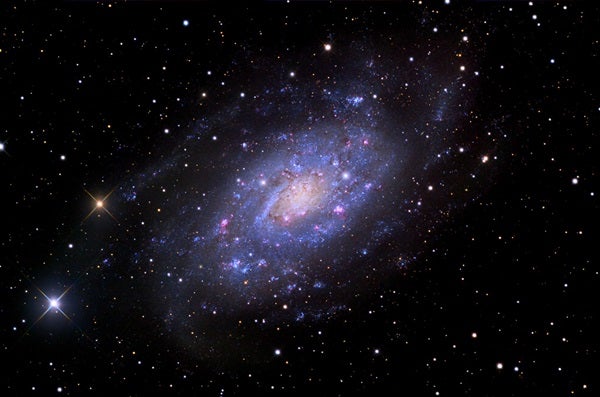The 18th-largest constellation, Camelopardalis, depicts a giraffe that stretches from the northern border of Perseus up to near Polaris. Its brightest star, designated Beta (β), is 4th magnitude. Camelopardalis is rich in galaxies, and the brightest is NGC 2403 at magnitude 8.9 — bright enough to see in large binoculars under dark skies.
Some 10 million light-years away, this Scd spiral lies in the outer regions of the M81 Group, the closest association of galaxies to the Local Group. It appears similar enough to M33 in Triangulum that Allan Sandage wrote a comparison of the two galaxies in his 1961 book The Hubble Atlas of Galaxies. NGC 2403 is 50,000 light-years in diameter and inclined to our line of sight by 60° — that’s 10,000 light-years smaller and 5° more inclined than M33.
NGC 2403 contains NGC 2404, a massive HII region roughly 940 light-years across. For comparison, the Large Magellanic Cloud’s Tarantula Nebula is 1,000 light-years across. These are all young star-making machines.
While NGC 2404 may require a large telescope to see well, more modest instruments can reveal NGC 2403’s spiral structure. Discovered by William Herschel in 1788, this galaxy isn’t difficult in a 4-inch and shows its generous 17.8′-by-11′ dimensions in an 8-inch. A 13-inch scope can tease out some of the spiral structure, and larger apertures show even more detail, including mottling from stellar associations and HII regions. There are faint foreground stars superimposed on this galaxy that might be mistaken for supernovae.
NGC 2403 is in an area lacking bright guide stars. If you want to star hop to find it, the best way is to find Omicron (ο) Ursae Majoris. Center on that star, then locate 23 Ursae Majoris. You’ll find NGC 2403 at the same distance and angle from that star but in the opposite direction, near 51 Camelopardalis.
Make sure to explore Astronomy’s full list of 101 cosmic objects you must see. New entries will be added each week throughout 2022.
To get the latest astronomical news and observing content delivered directly to your door, subscribe to Astronomy magazine today!










